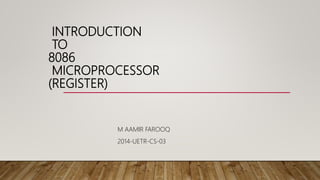
8086 Microprocessor Registers Introduction
- 2. REGISTER Defination A register is one of a small data holding places that are part of a computer processor . A register may hold a computer instruction ,a storage address , or any kind of data( such as bit sequence or individual charters). E.G A 8 bit register can store of 8 bit of data or 32 register can store of 32 bit of data What is register ? A register is a very small amount of very fast memory that is built into the CPU (central processing unit) in order to speed up its operations by providing quick access to commonly used values. o Registers are the top of the memory hierarchy and are the fastest way for the system to manipulate data. o Registers are normally measured by the number of bits. o Registers are used to store data temporarily during the execution of a program. Some of the registers are accessible to the user through instructions.
- 3. 8086 – INTRODUCTION o 16 bit µp with 20 bit address bus & 16 bit data bus o Can address up to 220 = 1 MB memory directly o Can read or write 8 or 16 bit data o 8088 - 8 bit data bus o Internal architecture has two main units • BIU - Bus Interface Unit • EU – Execution Unit o Registers are divided in 5 major categories: • General Purpose Registers • Pointer Registers • Index Registers • Segment Registers • Flag Registers
- 4. INTEL 8086 MICRO PROCESSOR ORGANIZATION
- 5. HOW DOES IT WORKING? o General Purpose Registers: There are four General Purpose Registers named as follows. . AX (Accumulator Register): commonly used for arithmetic & logic data transfer. . BX (Base Address Register): used to save the address of memory location. . CX (Count Register): keeps record of iterations while a LOOP instruction is running. . DX (Data Register): holds data of the instruction currently being executed. o Pointer Registers: • There are three pointer registers that are used to point toward some memory address. • BP (Base Pointer): points to the base element of the stack. • SP (Stack Pointer): always points to the top element of the stack. • IP (Instruction Pointer): stores the address of the next instruction to be executed. o Index Registers: • Index registers are used for indexed addressing and sometimes also used in addition and subtraction. There are two sets of index registers: • SI (Source Index): used as source index for string operations. • DI (Destination Index): used as destination index for string operations.
- 6. HOW DOES IT WORKING? o Flag Registers: These registers are programmable. It can be used to store and transfer the data from the registers by using instruction. o The common flag bits are: • Overflow Flag (OF): indicates the overflow of a high-order bit (leftmost bit) of data after a signed arithmetic operation. • Direction Flag (DF): determines left or right direction for moving or comparing string data. When the DF value is 0, the string operation takes left-to-right direction and when the value is set to 1, the string operation takes right-to-left direction. • Interrupt Flag (IF): determines whether the external interrupts like keyboard entry, etc., are to be ignored or processed. It disables the external interrupt when the value is 0 and enables interrupts when set to 1. • Trap Flag (TF): allows setting the operation of the processor in single-step mode. The DEBUG program we used sets the trap flag, so we could step through the execution one instruction at a time. • Sign Flag (SF): shows the sign of the result of an arithmetic operation. This flag is set according to the sign of a data item following the arithmetic operation. The sign is indicated by the high-order of leftmost bit. A positive result clears the value of SF to 0 and negative result sets it to 1.
- 7. • Zero Flag (ZF): indicates the result of an arithmetic or comparison operation. A nonzero result clears the zero flag to 0, and a zero result sets it to 1. • Parity Flag (PF): indicates the total number of 1-bits in the result obtained from an arithmetic operation. An even number of 1-bits clears the parity flag to 0 and an odd number of 1-bits sets the parity flag to 1. • Carry Flag (CF): contains the carry of 0 or 1 from a high-order bit (leftmost) after an arithmetic operation. It also stores the contents of last bit of a shift or rotate operation.
- 9. THANK YOU
